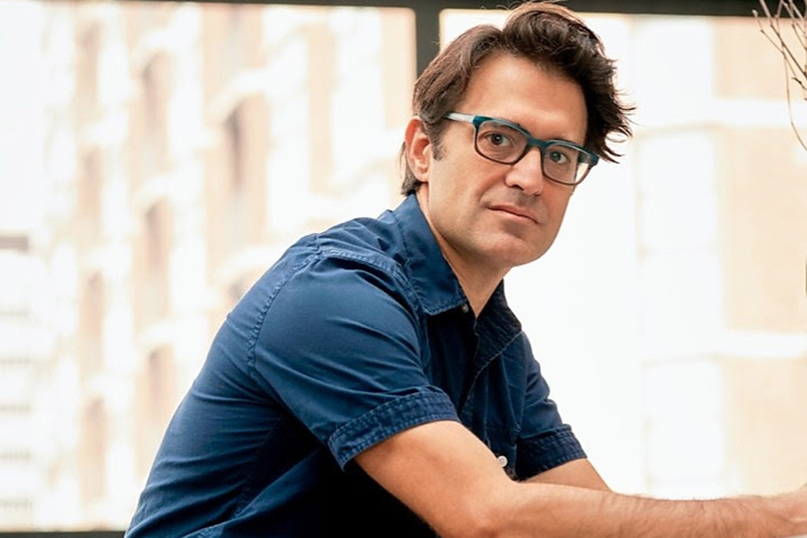
By Brian Slattery/New Haven Independent
There is a moment early in Squirrel Hill: The Tree of Life Synagogue Shooting and the Soul of a Neighborhood, by Westville-based author Mark Oppenheimer — released last month — that brings the writer’s intentions into crystal clarity. As part of his recounting of the largest antisemitic mass murder in U.S. history, Oppenheimer tells us about Daniel Leger, a 70-year-old hospice nurse who was inside the building on the morning of Oct. 27, 2018, with 66-year-old doctor and friend Jerry Rabinowitz when they heard the shooting start. They rushed toward the sound of gunfire to try to help.

“We did exactly what people who train you for crisis situations tell you not to do,” Leger recounted later. “We thought that we could somehow be helpful.”
Rabinowitz was shot and killed. Leger was critically wounded and figured he would not survive. In addition to being a hospice nurse, Oppenheimer tells us, Leger was a member of the New Community Chevra Kadisha, a holy society that performs tahara, the preparation of bodies for burial according to Jewish customs.
“It just seemed like a logical extension of the work that I had been doing as a hospice nurse,” Leger said later. “It was not so unusual for me to have had a patient in hospice, been present at their tahara, and then do the funeral and bury them.”
Leger had always assumed that when his own time came, his friends would perform tahara for him. “As the medics carried him into the ambulance, he lost consciousness,” Oppenheimer relates. “Then, at the hospital, he saw what he took to be the shadows of four people. He thought he was dead, and he wasn’t afraid. What he thought was My God, it’s the chevra kadisha. And they’re taking care of me.”
Drawn from hundreds of hours of interviews with dozens of residents of Squirrel Hill, from survivors to activists to bystanders, Oppenheimer’s book isn’t so much about the massacre at Tree of Life synagogue — in which 11 people (Joyce Fienberg, 75; Richard Gottfried, 65; Rose Mallinger, 97; Jerry Rabinowitz, 66; Cecil and David Rosenthal, 59 and 54; Bernice and Sylvan Simon, 84 and 86; Daniel Stein, 71; Melvin Wax, 88; and Irving Younger, 69) were murdered. Instead, it is about the community’s overwhelming response to it.
There is a retelling of the shooting, as there needs to be to understand what follows. But Oppenheimer quickly moves from the horrific event itself to the way the violence affected so many, both within the neighborhood’s vibrant Jewish community and beyond.
It’s a story about dealing with trauma, about the long road of coming to terms with what happened, and about the questions it raises — not about why bad things happen to good people, but about what people can do about it when bad things happen.
In The Neighborhood
The focus of Oppenheimer’s book steers him immediately away from a discussion of the motivations of the shooter, Robert Bowers. It’s a brave choice and an important one. Other writers have already covered some of that ground. Bowers himself — who is still awaiting trial — spelled out on social media the deep anti-immigrant and antisemitic rage that fueled his attack. It’s natural to want to probe these motivations further to try to understand why he (or anyone) would commit mass murder. Maybe a book about Bowers would yield the kind of harrowing insight Dave Cullen offered in his writing about the Columbine school shooting. But maybe the same research would run up against a version of Hannah Arendt’s “banality of evil,” the term she coined to describe Adolf Eichmann’s maddeningly shallow defense for being a major organizer of the Holocaust; even in the face of a capital trial for murder on a scale and ferocity that horrified the world, Eichmann submitted that he was just following orders.
Oppenheimer isn’t interested in delving broadly into the psychology of mass killers, about which much has been written. In turning to the neighborhood of Squirrel Hill — and following what happens in it for the first year after the shooting — he ventures into much less well-trod territory. He takes on the complicated issues regarding whether and how people persevere, how those in a community sustain themselves and one another, after an episode of mass violence. He sheds light on the basic questions of what people do when confronted with choices of whether and how to intervene and help, and how to do the work of recovery — the same kinds of questions embedded in the study of genocide, and in school curricula like Facing History and Ourselves (the magnet theme of New Haven Academy).
Addressing those questions begins with getting to know individual people, not solely as individuals, but as threads in the social fabric of Squirrel Hill.
“There were a number of people who could have been books unto themselves,” Oppenheimer said. In addition to Leger, whose story runs through the book, there is Tammy Hepps, a community organizer. “I also think that Jerry Rabinowitz, who scarcely shows up in the book — who was murdered, and who was this extraordinary doctor, who was one of the principal primary care physicians for people with HIV back in the ‘80s and ‘90s — deserves a book of his own,” Oppenheimer said. “And it was hard to resist the temptation to write books about these extraordinary people. But I really did keep getting pulled back to the idea that the protagonist was the neighborhood.”
Oppenheimer was first drawn to the story because he had a family connection to Squirrel Hill and a reporter’s curiosity for how the neighborhood was coping. When he first began his research for the book, “I came in with the idea that I wanted to meet as many people as possible in Squirrel Hill, and if I had a thesis, it was the pretty obvious one that something like this touches everybody,” Oppenheimer said. Five months later, after about a dozen trips to Pittsburgh meeting people and getting to know the place, “I realized there was no one character emerging, that instead it was entire social networks of characters, spread out across this geographically small but spiritually really dense place called Squirrel Hill. If you walk around the neighborhood, it insists on itself as a serious place. There’s street life. The shop windows all had these ‘Stronger Than Hate’ signs that I write about.” And, in the winter of 2018-19, “there were all of these stars of David and snowflakes and hearts that people had made from all over the world, that were hanging in the trees. So you would walk down Forbes Avenue, in the heart of the business district, and there was this reminder … it was as if angels were there. It was really, really deep to be there. It was kind of inescapable, and I wanted to capture that.” Or, he added with humility, try to.
Making the neighborhood itself the primary subject meant adopting a somewhat unusual structure for a nonfiction book, of hopping from person to person, and to some extent backward and forward in time, even as the year progressed. “The idea of bouncing both chronologically but also across different points of view — moving through a year, but also shifting perspective throughout that year — I think came pretty organically,” Oppenheimer said. “It’s when I sat down and kept outlining the book, and re-outlining the book, and figuring out how to get in all the stuff I wanted to get in — it just kind of eventually emerged.”
In structuring the book he thought back to J. Anthony Lukas’s Common Ground, about racial tensions in Boston in the 1960s and 1970s. His “love of short chapters” came from Mrs. Bridge, a novel by Evan S. Cannell. He took inspiration from Janet Malcolm. He didn’t write the sections in the order in which they appear in the book. The first part he wrote was about the community’s observance of Tisha B’av — “the bleakest holiday on the Jewish calendar,” as he describes it in the book, commemorating a series of disasters that have befallen the Jewish people on that day, including the destruction of the First and Second Temples in Babylon and Jerusalem — “because that was a moment when all of these disparate characters were in one place, chanting the liturgy … and the liturgy is the Book of Lamentations.” It seemed to pull together so many who had been involved. “In some ways the book radiated backward and forward from there.”
The sense of a roving eye gives the first part of the book velocity and high emotional impact. Fred Rogers, perhaps Squirrel Hill’s most famous resident, once said in times of calamity to “look for the helpers.” Oppenheimer shows them to us, from those who guarded the bodies to those who organized community gatherings and collected donations. The outpouring of compassion is a deluge, and it is moving stuff.
Hard Questions
The opening chapters also set the reader up for the more complicated questions that arise as the initial months pass. What should be done with the physical building of Tree of Life? What is the best use of the donated funds, and who gets to decide how they’re allocated? These trickier situations reach a head at a huge community gathering a year after the event. The speakers agree beforehand that they won’t talk about politics. But then Rabbi Jonathan Perlman of the New Light Congregation does just that. He’s criticized for his outspokenness. But then, can we talk about what happened at Tree of Life without talking about politics? Without mentioning gun control, or the rhetoric of a certain former president and the possibility that it gave courage to antisemites?
“That’s really a question that Tammy Hepps was posing: is this all Jews can be? Just take care of each other and not have prophetic witness about gun control, or White supremacy, or Trump?” Oppenheimer said. “She struggles with that, and I wanted to show her struggle. I wanted to show Rabbi Perlman’s struggle.”
There are no easy answers to these questions — not really — and in giving space for so many to speak, Oppenheimer is able to present those questions in all their complexity. “I don’t have a lot of conclusions about this stuff,” he said. Deeper still, he has a keen sense of limits of his own understanding. “After 32 trips to Pittsburgh, I still don’t think I know what it was like to be at or close to a mass killing,” he said. “Just as, before we went through a pandemic, we could have imagined what it was like to go through a pandemic, but we didn’t know what it was like to go through a pandemic.” Still, he added, “maybe writing this book brought me closer to understanding what it was like to be near Tree of Life, or in Squirrel Hill, at the time.” There’s a good word for the act of trying to connect with another person’s experience while knowing that full understanding is impossible: at its heart, Squirrel Hill is a work of profound empathy.
Oppenheimer doesn’t see his book as the final, definitive word on what the Tree of Life massacre means — for the survivors, for the neighborhood, for Pittsburgh, for Jews, or for the country. “There are people from the community who have written about it, and more will write about it, and that’s all to the good. There’s no cap on the number of different perspectives we can have, or the number of different versions out there,” he said. “Hopefully people will keep talking about the Tree of Life shooting. The great fear is that nobody will keep talking about the Tree of Life shooting. When I talk to Gentiles now about the book I’m working on, and I say, ‘it’s about the shooting in Pittsburgh,’ most of them say, ‘what shooting in Pittsburgh?’ Because there have been other mass shootings since, and people move on in America. It’s special to me because I wrote about it and also because I’m Jewish, and I think the Jewish community remembers it, just as I think the Black community remembers the shooting in Charleston, and the gay community and the Latino community remember the shooting at Pulse, in Orlando. But there have been several hundred killings of four or more people since Columbine, and most of us don’t remember most of them.”
In that sense, Oppenheimer sees himself as writing for the widest audience possible — “curious readers,” as he put it. While acknowledging the book’s importance to Jews, “the book will be a failure if only the Jewish community pays attention.”
That matters because “I think America is definitely entering one of its cyclical periods of heightened antisemitism, and I think that there is a lot to be said about it that I didn’t touch on, and there will be people who think more deeply and profoundly about why hatred cycles back to the Jews. But it’s pretty concerning,” Oppenheimer said.
He pointed to a recent survey from the Cohen Research Group, partnering with the Louis D. Brandeis Center, showing that half of Jewish college students had at some point hidden their identity, and 65 percent had felt unsafe on campus.
“In the several decades after the Holocaust, the Western world felt so guilty that there was a bit of a holiday from overt antisemitism, at least in the United States, Canada and Australia. But I think that’s coming to an end, and we’re probably resetting to normal levels of it, which are too high,” Oppenheimer said. He sees it in the rise of conspiratorial thinking in the far right, and also in some of the pro-Palestinian statements from the far left. He sees it — and tolerance for it — in the general “willingness to forgive and forget who Louis Farrakhan really is, as an antisemite and a homophobe,” and in the “continued career of Mel Gibson, who has referred to Jews as ‘oven dodgers.’” He sees it also in the relative inattention paid to the attacks on Orthodox Jews in Brooklyn in recent years, and in the recent murders of Jews in Jersey City.
But Squirrel Hill isn’t a polemic against antisemitism, or a full-throated argument for gun control, or a broadside against the former president. It’s about a neighborhood in Pittsburgh, the way it rallied around those most harmed by a single brutal attack, and the way it continues to find a way into the future without forgetting the past. In the face of the many questions the book raises, the people of Squirrel Hill seem to be providing something like answers, if only in how they live their lives.
“I really do feel like this is a hopeful book,” Oppenheimer said. “The portrait of warm, caring community is big enough to drown out the germ of evil that got this all started.” The shooter, he said, “really is one guy. There are other people who share his ideology, but this was the act of one person. That’s not bigger than the thousands of people in Squirrel Hill.”
Mark Oppenheimer will speak at the Mandell JCC on Sunday, Nov. 7. For information, visit mandelljcc.org.
This is article first appeared in the New Haven Independent (www.newhavenindependent.com) and is reprinted with permission.







 Southern New England Jewish Ledger
Southern New England Jewish Ledger













